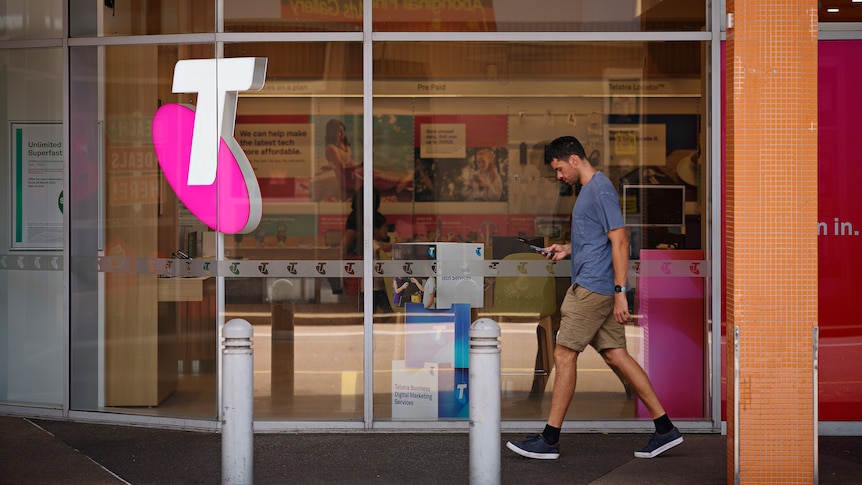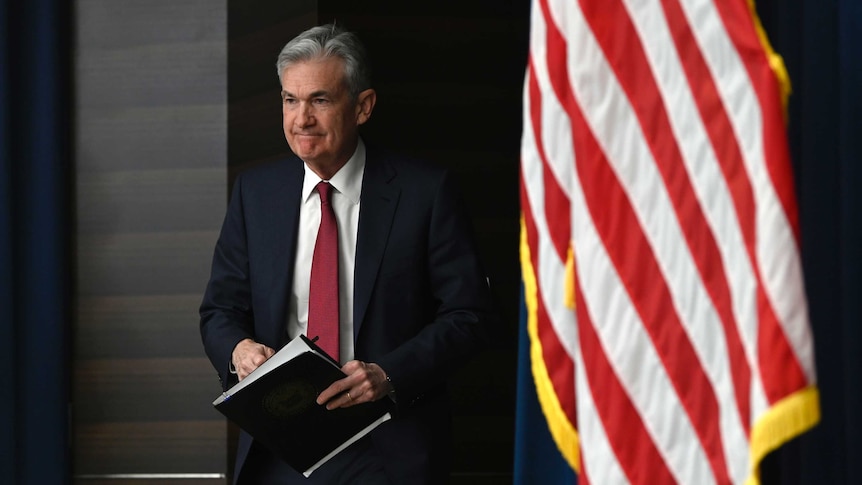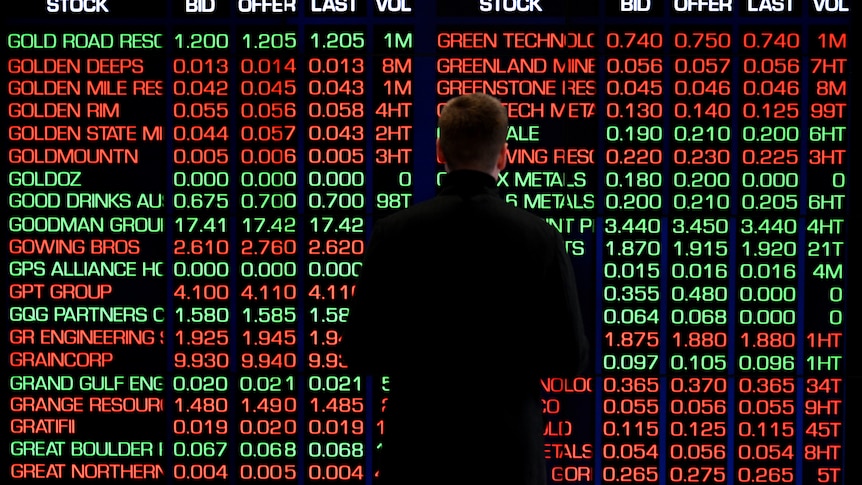Telstra has seen a fall in profits for the year, but it has raised dividends for investors, and the ASX has soared on the back of cooling US consumer inflation.
Key points:
- The Dow Jones index rose 1.6pc to 33,310, the S&P 500 rose 2.1pc to 4,210, and the Nasdaq rose 2.9pc to 12,855
- US consumer prices rose 8.5pc over the year to July, a slowdown from 9.1pc over the year to June
- Telstra’s annual net profit fell 4.6pc to $1.8 billion, but its final dividend lifted from 8 cents to 8.5 cents a share
The telecommunications giant said annual profit slipped for 2022 because of lower revenue and total income.
Net profit after tax fell 4.6 per cent to $1.8 billion, with total income falling by nearly 5 per cent to $22 billion.
Before-tax earnings dropped 5 per cent to $7.3 billion.
Telstra sold more mobile services but saw less demand from retail customers for fixed bundle and data services.
Despite the fall in profit, Telstra announced an increase in its dividend for the first time in seven years, following the completion of its four-year transformation plan, T22.
Telstra paid a final fully franked dividend of 8.5 cents a share, bringing the total dividend for the year to 16.5 cents a share.
That is up to 3.1 per cent and includes a special dividend of 3 cents a share for the year.
Outgoing Telstra chief executive Andy Penn said the company’s core business performed strongly despite the challenges.
“What we could not have foreseen was COVID and the other seismic economic, political and social changes that have unfolded,” Mr Penn said.
“Our mobiles result was outstanding, consumer and small business fixed grew sequentially in the second quarter, enterprise returned to growth, and we started to realize the benefits of setting up our infrastructure assets as a standalone InfraCo business.”
Telstra shares lost their gains, and were down 1 per cent to $3.97 at 3:20pm AEST.
ASX jumps
The Australian share market surged more than 1 per cent in early trade on hopes that the US Federal Reserve would not make another super-sized interest rate hike next month because of a pullback in prices in July in the US.
At 3:15pm, the All Ordinaries index was up 1 per cent to 7,311, while the ASX 200 index rose 9 per cent to 7,057.
Most sectors increased on the ASX 200, with industrials, technology and consumer stocks leading the gains.
National Australia Bank, ANZ, Westpac gained ground, but the Commonwealth Bank was lower.
Just education stocks and utilities were weaker.
Lithium firm Lake Resources (+15.5 per cent) and fashion retailer City Chic Collective (+11.5 per cent) did the best, with share registry Computershare (-4.3 per cent) doing the worst.
The Australian dollar jumped around 1.5 US cents overnight from yesterday’s close as the greenback fell.
It reached an overnight high of 71.09 US cents.
At 3:20pm AEST, the local currency was down 0.1 per cent to 70.68 US cents.
AMP returns $1.1 billion to investors
Financial house AMP saw a fall in underlying half year profit because of lower profit margins at its banking division and share market volatility.
Underlying net profit fell by one quarter to $117 million for the first half of the financial year.
That is as net interest margin, the difference between what the bank pays for finance compared to what it charges customers, slipped.
AMP said NIM fell to 1.32 per cent from 1.62 a year earlier because of competition in the home loan market and a preference towards lower margin fixed rate loans, which has since subsided.
The company said higher interest rates will help its profit margins over the second half of the year.
Investments under management also took a hit because of falling share market returns over the first half of the year with funds under management falling from $142.3 billion a year ago to $126.3 billion.
Net profit for the first half of the year increased to $481 million after it sold its infrastructure debt business, up more than threefold.
But in good news for investors, the company is returning $1.1 billion in capital to shareholders, although it did not pay an interim dividend.
AMP shares were down 1.5 per cent to $1.15 in late trade.
Meanwhile, insurer QBE said net profit after tax for the half year slumped from $441 million a year ago to $151 million for the six months to the end of June, down by two-thirds.
That is because of share market volatility and record storms and floods in Australia.
Investors get an interim dividend payout of 9 cents a share.
QBE shares rose 3.4 per cent to $12.56 in the last hour of trade.
US inflation slows
The US Consumer Price Index was flat in July after rising by 1.3 per cent in June, when prices reached an annual rate of 9.1 per cent — the highest in 41 years.
The US Labor Department said over the year to July, prices rose at the slower pace of 8.5 per cent, better than expected by economists.
The data is the first notable sign of relief for Americans who have watched inflation steadily climb over the past two years.
The US central bank, the Federal Reserve, is considering whether to make another large interest rate increase of 0.75 per cent in September, after a string of rate rises this year.
July’s slowdown in monthly inflation was the largest since 1973 and followed on the heels of petroleum prices falling by around one-fifth since mid-June.
Prices at the pump spiked in the first half of the year because of the war in Ukraine and reached a record high of more than $US5 a gallon in mid-June.
Gasoline prices fell 7.7 per cent in July, but food prices remained elevated, climbing by 1.1 per cent.
However, prices are still rising at levels not seen since the high-inflation era of the 1970s and early 1980s.
loading
The core consumer price index, which strips out volatile energy and food prices, rose 0.3 per cent in July from June, and 5.9 per cent from a year earlier.
US consumer prices have surged for a variety of reasons including the global supply-chain squeeze, massive government stimulus from the COVID-19 pandemic, and Russia’s invasion of Ukraine.
Chicago Federal Reserve president Charles Evans said the inflation reading was the first “positive” one since the central bank began raising interest rates earlier this year.
But he said inflation was still “unacceptably” high and the Fed would continue to need to raise rates likely to between 3.25 per cent and 3.5 per cent this year, and to between 3.75 per cent and 4 per cent by the end of next year.
“This is not yet the meaningful decline in inflation the Fed is looking for,” Paul Ashworth of Capital Economics said.
“But it’s a start and we expect to see broader signs of easing price pressures over the next few months.”
US stocks surge
Wall Street rallied after the US inflation report came out, with investors betting the Federal Reserve might raise official interest rates by 0.5 percentage points instead of 0.75 percentage points next month.
The Nasdaq and S&P 500 surged more than 2 per cent.
By the close, the Dow Jones Industrial Average rose 1.6 per cent to 33,310, the S&P 500 rose 2.1 per cent to 4,210, and the Nasdaq Composite rose 2.9 per cent to 12,855.
All 11 sectors on the S&P 500 gained, led by miners, consumer staples and technology stocks.
The US inflation data calmed nerves in Europe.
The FTSE 100 index in London rose 0.25 per cent to 7,507, the DAX in Germany rose 1.2 per cent to 13,701, and the CAC 40 in France rose 0.6 per cent to 4,954.
Brent crude oil rose 0.8 per cent to $US97.11 a barrel, while spot gold fell 0.1 per cent to $US1791.39 an ounce.
ABC/Reuters
.



